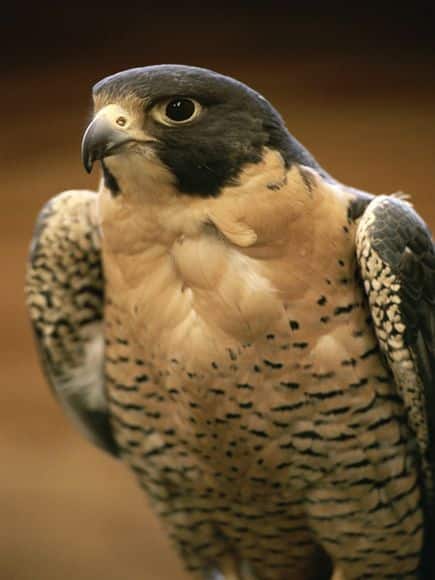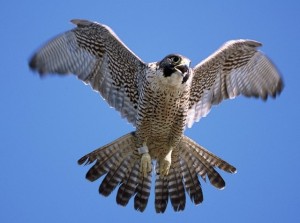The peregrine falcon belongs to a group of birds called the Falconiformes. This group includes vultures, kites, hawks, eagles, and falcons. Other than vultures, all of these birds hunt and kill other animals for food. Falconiformes are equipped with hooked beaks and strong talons, making them excellent predators. All Falconiformes are daytime hunters.
The peregrine falcon is the best-known of the fifty-eight birds in the falcon family. The word Peregrine comes from a word that means, “one who wanders.” This falcon has definitely earned its name. For example, some of Canada’s tundra peregrines fly to Brazil each winter.
Peregrine falcons are found in every single part of the world except Antarctica. They were once trained by kings to hunt and bring back kills. This sport, called Falconry, is still popular. However, in the 1960s the American falcon came close to extinction.
Most of the damage was done by poisons that farmers used to kill insects. The worst poison was DDT. By the time naturalists learned of DDT’s effect on wildlife, it was almost too late.
The American peregrine’s scientific name is Falco peregrinus anatum. At one time, people called this falcon a duck hawk. That was a poor name, since falcons aren’t hawks and they rarely kill ducks. The American peregrine was once found all across the eastern United States and southern Canada. In the west, the species was found from Mexico to California. DDT poisoning hit this subspecies the hardest. Even today, naturalists are still working hard to save the American peregrine from extinction.
The smaller tundra peregrine (Falco peregrinus tundrius) lives farther north. Tundra peregrines range across the treeless regions of Alaska and Canada. They are also found in Greenland. Peale’s peregrine (Falco peregrinus pealei) is the third North American subspecies. This western bird ranges from Oregon northward to Alaska and the Aleutian Islands. Peale’s peregrine is the largest of the three subspecies. The tundra and Peale’s peregrines have escaped the worst effects of DDT poisoning.
Most peregrines are slate blue on the back and wings. The top of its head is black. Black feathers around the eyes reduce glare and improve the bird’s vision. The white underside of a Peregrine’s wings, tail, and chest show more bands of dark feathers.
A peregrine falcon is a medium-sized bird about the size of a crow. Female peregrines are larger and heavier than the males. An average female (called a falcon) weighs a little over two pounds. The female is eighteen inches in length from beak to square tail. Her long, pointed wings measure forty-five inches from tip to tip. The male bird (called a tiercel) is only two-thirds the size of his mate. Therefore, a typical tiercel weighs only one and one-half pounds. His body is two inches shorter and his wings are four inches shorter than the female.
A peregrine’s feathers make its high-speed flight possible. The feathers lie close to its streamlined body. Like all birds, peregrines lose their feathers and grow new ones. This process is called molting. A peregrine’s molt lasts from April to October. It loses only a few feathers at a time. If too many feathers fell out, peregrines wouldn’t be able to fly.
In-flight, a peregrine’s wings look long and pointed. Close to the body, however, the wing is wide and strong. This gives the falcon the lift it needs to carry a heavy kill. In level flight, these swift falcons reach speeds of sixty miles an hour. During a dive, peregrines reach their highest speeds. They fold their wings halfway back and drop like a missile. An air force pilot once clocked a diving peregrine at 175 mph!
The peregrine’s feet and beak are also designed for killing. Each yellow foot has four toes; three in front and one behind. Each toe ends in a curved claw called a talon. When a peregrine dives at its prey, it strikes first with the razor-sharp back talons. This blow usually kills the prey instantly. If the prey is still alive, the peregrine uses its strong, tan-colored beak. One slashing bite with its beak will break the back of smaller birds.
The peregrine’s large eyes give it superior vision. Each black, shiny eye weighs about one ounce. If a falcon were the size of a human, its eyes would weigh four pounds each! A falcon’s eyes are set toward the front of its head. It cannot see in all directions at the same time. If it hears a noise from behind, it will simply turn its head all the way to the rear! The peregrine doesn’t see colors, as well as humans, do, although it can see eight times as far as a human.
Naturalists do not know how peregrines find their way back to their nests. They think that the bird somehow remembers the look of nearby fields, woods, and rivers. Peregrines are equally at home in big cities. To them, a tall building is just another natural stone cliff. City peregrines nest on building ledges and feed on pigeons and starlings.
Along with keen eyesight, peregrines have good hearing. Peregrines don’t make warning cries, but they listen to the warning calls of other birds. A peregrine is usually silent while it is hunting. Around its own nest, a peregrine makes a number of calls. To attract a mate, the tiercel makes a series of tweeting and wailing cries. If a human comes too close to the nest, the peregrine makes an angry warning cry that sounds like: “cack, cack, cack.” If the warning cry fails, the falcon will fly directly at the face of the stranger.
Taste and smell are less important. Peregrines don’t have many taste buds on their tongues. Therefore, a peregrine will eat birds that taste terrible to humans. Similarly, peregrines can smell odors, but they don’t use this sense in hunting. When its dinner is flying far below, the peregrine must depend on its eyesight.
When left alone, peregrines may live as long as twenty years. One famous falcon nested on the Sun Life building in Montreal, Canada for eighteen years. Many peregrines die in their first year of life, however. Even without DDT, the peregrine’s habitat holds many dangers.
Today, the peregrine has almost vanished. The tundra and Peale’s peregrines have been less affected by the poisons. They can still be found in many of their northern and western ranges.
Peregrine falcons were once found over most of North America. Their favorite habitat is a rocky cliff that overlooks open country. These cliffs are often found near rivers and lakes along the seacoast. A peregrine’s habitat also needs a food supply of songbirds, pigeons, and waterfowl.
Peregrines spend their summers in the northern half of their range. When winter drives the smaller birds south, the peregrines join the migration. Cold weather doesn’t seem to bother them, but they must have food. Tundra peregrines fly the farthest of all falcons. Some fly to Florida and Central America. Others travel all the way to Brazil. American peregrines and Peale’s peregrines do not fly as far.
The young birds don’t need a guide. Instinct tells them where to go when the food supply flies south. When the first frost hits in the south, all peregrines begin following their prey back north. They usually return to their nest, although on some occasions their nest may be gone or they followed their prey into a new habitat. When this happens, they simply find an ideal place to live and build their nest.
After the attack of DDT, a man named Heinz Meng decided to attempt to raise peregrines in cages. Most naturalists told him he was crazy! They claimed that peregrines would only mate in their natural habitat. Meng knew that a German falconer had bred peregrines in the 1940s. Meng decided to go on with his experiment. He started in 1964, but he had many failures. Finally, in 1971, his peregrines hatched a tiny eyas. Meng was overjoyed. Peregrines could be bred in captivity!
At Cornell University in New York, Dr. Tom Cade started Project Peregrine. Cornell raised money to build a long barn for his peregrines. The barn had two story “apartments” that made good nests. Meng and other falconers donated birds of mating age. Cade also wanted to raise his own mating pairs. The government let him take a few Peale’s peregrines from Alaska. A female named Cadey was one of the eyases he found there.
In 1973, Cadey mated with a tiercel named Heyoka. She laid four eggs. Cade took the eggs away. Cadey laid four more. Again, the naturalist removed the eggs. Cadey fussed at him, but she laid four more eggs! Cade and his helpers put the eggs in an incubator. Three weeks later, Project Peregrine’s first eyases pecked through their shells.
For two weeks, the team members fed and cared for the eyases. Then they put the little ones back with Cadey and Heyoka. The adult birds took good care of the eyases. That year, twenty eyases lived and learned to fly in the barn. The question was, would the young peregrines learn to hunt on their own?
One of the young tiercels answered that question. Taken to the outdoors to fly, he began to dive at pigeons. Instinct told him that small birds were his natural prey. A few weeks later, the tiercel flew up to chase away another predator from his territory. This time, he didn’t return.
In 1978, the project produced 95 eyases. Cade and his helpers began releasing the peregrines. They fed them for a while, but the falcons soon learned to hunt on their own. The Project birds began nesting on nearby cliffs. Peregrines were once more living in the wild in the eastern United States.
Soon after this project took place, another started. The plan was to put peregrines into a new habitat: America’s big cities. The record showed that peregrines had done well in Montreal, New York, and other cities. In 1981, a team turned nine peregrines loose in Los Angeles, California. Eight of the birds survived the first year.
The peregrines found their own nests. Several falcons nested on the ledges of the Plaza Building in Westwood. Two more picked out the Union Bank skyscraper in downtown Los Angeles. Another bird moved out to the coast at Marina del Rey. Local citizens couldn’t believe their eyes. They looked up to see peregrines chasing pigeons down Wilshire Boulevard!
Naturalists still have their fingers crossed. So far, the news is good. The peregrine falcon is coming back from extinction!


